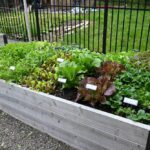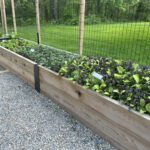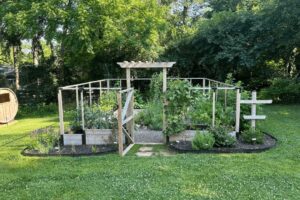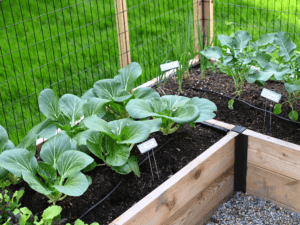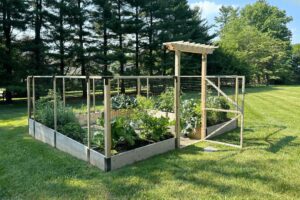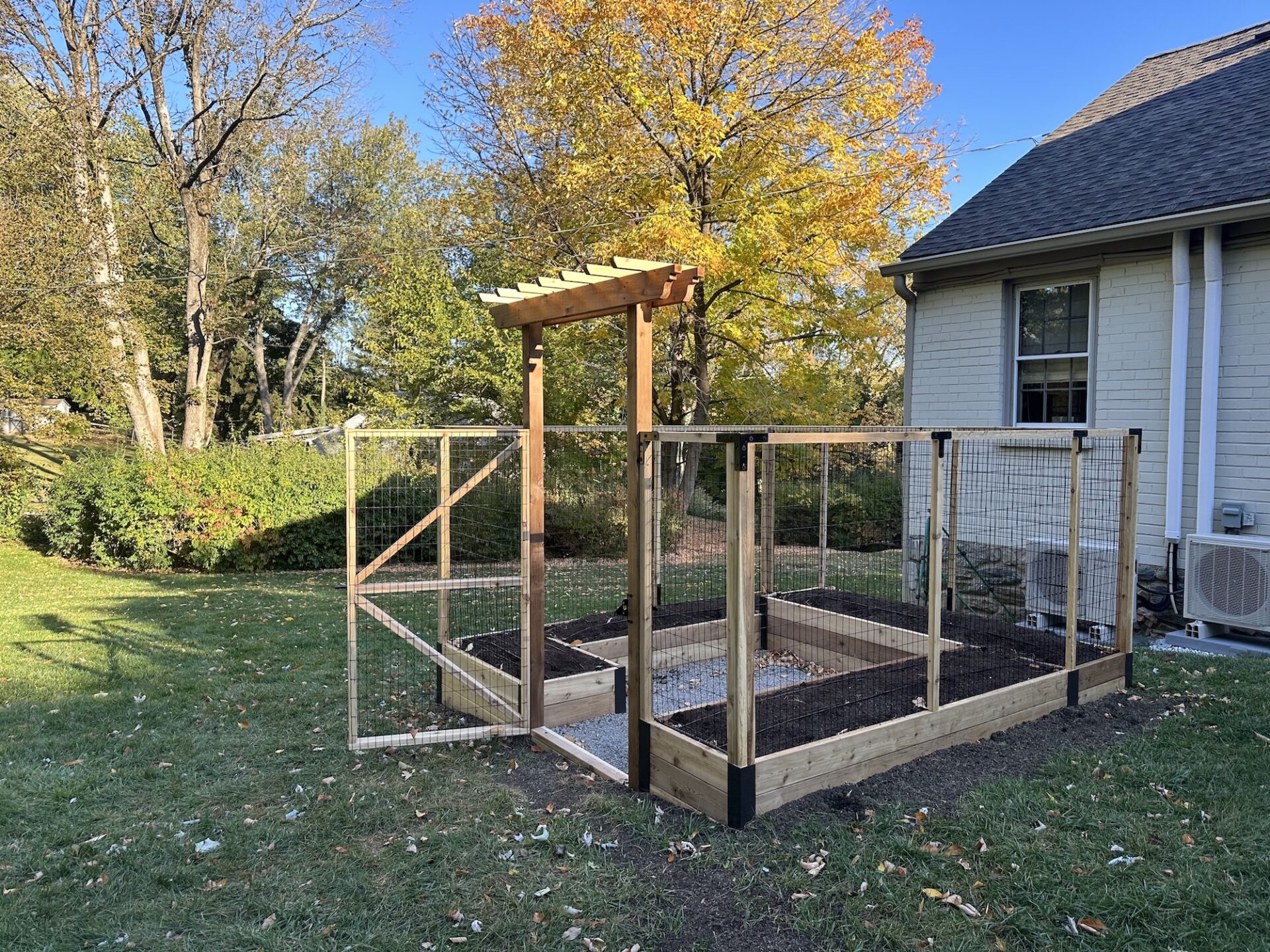
[et_pb_section fb_built=”1″ admin_label=”section” _builder_version=”4.16″ da_disable_devices=”off|off|off” global_colors_info=”{}” da_is_popup=”off” da_exit_intent=”off” da_has_close=”on” da_alt_close=”off” da_dark_close=”off” da_not_modal=”on” da_is_singular=”off” da_with_loader=”off” da_has_shadow=”on”][et_pb_row admin_label=”row” _builder_version=”4.16″ background_size=”initial” background_position=”top_left” background_repeat=”repeat” global_colors_info=”{}”][et_pb_column type=”4_4″ _builder_version=”4.16″ custom_padding=”|||” global_colors_info=”{}” custom_padding__hover=”|||”][et_pb_text _builder_version=”4.27.3″ _module_preset=”default” text_text_color=”#000000″ link_font=”|700|||on|||#000000|” link_text_color=”#000000″ header_2_line_height=”1.5em” header_2_font_size_tablet=”” header_2_font_size_phone=”23px” header_2_font_size_last_edited=”on|phone” global_colors_info=”{}”]
Raised bed gardening is an accessible, effective way to grow your own food. However, the materials used in your raised beds significantly impact the garden’s durability, functionality, and aesthetic appeal. This post explores the pros and cons of common raised bed materials—wood, metal, and stone—to help you make the best choice for your garden.
[/et_pb_text][et_pb_text _builder_version=”4.27.3″ _module_preset=”default” text_text_color=”#000000″ link_font=”|700|||on|||#000000|” link_text_color=”#000000″ header_2_line_height=”1.5em” header_2_font_size_tablet=”” header_2_font_size_phone=”23px” header_2_font_size_last_edited=”on|phone” global_colors_info=”{}”]
Why Are Materials Important?
The materials in your raised beds influence factors like soil quality, plant growth, and maintenance requirements. Different materials react uniquely to weather, moisture, and temperature, all of which directly affect plant health. By choosing the right materials, you can create a productive, long-lasting garden that suits your space and climate.
[/et_pb_text][et_pb_text _builder_version=”4.27.3″ _module_preset=”default” text_text_color=”#000000″ link_font=”|700|||on|||#000000|” link_text_color=”#000000″ header_2_line_height=”1.5em” header_2_font_size_tablet=”” header_2_font_size_phone=”23px” header_2_font_size_last_edited=”on|phone” global_colors_info=”{}”]
Raised Bed Kits vs. Custom Gardens
For beginners, raised bed kits offer an affordable way to start gardening. They’re convenient, modular, and easy to place in most spaces. However, while these kits are budget-friendly and beginner-friendly, they may lack the structural durability and flexibility of custom-built beds. Custom raised beds, particularly those made from wood, provide greater stability and design freedom, accommodating additional infrastructure such as fencing, irrigation, and pathways for a more versatile gardening experience.
In short, raised bed kits work well for new gardeners looking for an easy entry point. However, custom-built beds, especially wooden ones, provide a sturdier foundation for long-term gardening projects. With custom beds, you can also expand your garden layout to allow for larger crops, efficient pathways, and better soil management.
[/et_pb_text][et_pb_image src=”https://backyard-eats.com/wp-content/uploads/2024/11/IMG_5563-1-scaled.jpg” alt=”Baby greens in a raised bed” title_text=”IMG_5563 (1)” show_bottom_space=”off” _builder_version=”4.27.3″ _module_preset=”default” custom_margin=”20px||20px||true|false” global_colors_info=”{}”][/et_pb_image][et_pb_text _builder_version=”4.27.3″ _module_preset=”default” text_text_color=”#000000″ link_font=”|700|||on|||#000000|” link_text_color=”#000000″ header_2_line_height=”1.5em” header_2_font_size_tablet=”” header_2_font_size_phone=”23px” header_2_font_size_last_edited=”on|phone” global_colors_info=”{}”]
Wood: Our Choice For Raised Beds
Wood is our preferred material for raised beds. It’s versatile, durable, and cost-effective, providing benefits that many other materials cannot match. Wood can be cut and customized to fit any garden space and lends itself to a variety of designs, such as the popular “U-shaped” raised bed. This layout maximizes growing space and reduces the need for pathways, making it more efficient than individual raised beds often found in metal kits.
Another key advantage of wood is its breathability, which improves soil aeration and drainage. Wood naturally allows excess moisture to escape, preventing root rot and promoting healthier root growth, especially in areas with heavy rain. This breathability, combined with wood’s durability, makes it an excellent choice for maintaining plant health over time.
Additionally, wood is relatively easy to work with and is generally cost-effective. Cedar is especially well-suited for raised beds due to its natural rot resistance, providing a chemical-free, safe environment for edible plants. Reinforced with sturdy hardware, wooden beds can endure the elements and support larger plants, making them ideal for both beginner and experienced gardeners.
[/et_pb_text][et_pb_image src=”https://backyard-eats.com/wp-content/uploads/2024/11/17__Tall_L-Shaped_Raised_Garden_Bed_Kit-1.jpg” alt=”Metal raised beds” title_text=”17__Tall_L-Shaped_Raised_Garden_Bed_Kit (1)” show_bottom_space=”off” _builder_version=”4.27.3″ _module_preset=”default” custom_margin=”20px||20px||true|false” global_colors_info=”{}”][/et_pb_image][et_pb_text _builder_version=”4.27.3″ _module_preset=”default” global_colors_info=”{}”]
Photo by Jiaming Zhang on Wikimedia Commons
[/et_pb_text][et_pb_text _builder_version=”4.27.3″ _module_preset=”default” text_text_color=”#000000″ link_font=”|700|||on|||#000000|” link_text_color=”#000000″ header_2_line_height=”1.5em” header_2_font_size_tablet=”” header_2_font_size_phone=”23px” header_2_font_size_last_edited=”on|phone” global_colors_info=”{}”]
Metal Raised Beds: Pros and Cons
Metal raised beds are popular for their simple, modular setup, which makes them easy to place and rearrange. However, they have significant limitations, especially concerning heat retention. Metal absorbs and holds onto heat much longer than wood, which can be detrimental to plant health in warmer months. During the peak of summer, metal beds can overheat, “frying” tender seedlings and stressing established plants. This excessive heat disrupts plant growth, leading to potential crop failure.
The primary structural weakness in metal beds lies at the connection points, often held together by screws. These screws are prone to rust or loosening in wet conditions, which weakens the entire bed. Over time, these beds can become unstable and challenging to repair if parts warp or corrode. While galvanized steel is more durable and rust-resistant, it still holds more heat than wood, which poses a risk to plant health. Some metal bed designs also feature sharp edges that may be unsafe for gardeners during planting and maintenance.
[/et_pb_text][et_pb_image src=”https://backyard-eats.com/wp-content/uploads/2024/11/1024px-Hochbeet_aus_Naturstein.jpg” alt=”A narrow raised bed garden with fencing and an adjacent raspberry trellis” title_text=”1024px-Hochbeet_aus_Naturstein” show_bottom_space=”off” _builder_version=”4.27.3″ _module_preset=”default” custom_margin=”20px||20px||true|false” global_colors_info=”{}”][/et_pb_image][et_pb_text _builder_version=”4.27.3″ _module_preset=”default” global_colors_info=”{}”]
Photo by Neptuul on Wikimedia Commons
[/et_pb_text][et_pb_text _builder_version=”4.27.3″ _module_preset=”default” text_text_color=”#000000″ link_font=”|700|||on|||#000000|” link_text_color=”#000000″ header_2_line_height=”1.5em” header_2_font_size_tablet=”” header_2_font_size_phone=”23px” header_2_font_size_last_edited=”on|phone” global_colors_info=”{}”]
Stone Raised Beds: Pros and Cons
Stone is less common in raised bed kits, but it offers an attractive and natural look that blends well with landscapes. However, stone’s high thermal mass can be a drawback. Like metal, stone retains heat, and this heat can build up to levels harmful to plants. In hot weather, stone beds can radiate excessive heat into the soil, causing root stress and dehydration that stunts plant growth or kills tender crops. The impact on plant health can be significant, especially in regions with intense sunlight.
Additionally, stone beds are a more permanent installation. They’re difficult to reposition, and any repairs often require disassembling the entire structure. Because stone beds are heavy and require careful stacking, proper installation is more challenging and may require masonry skills. Stone beds are ideal for gardeners looking for a long-term solution and a semi-permanent garden structure, but they don’t offer the flexibility or adjustability of wood.
[/et_pb_text][et_pb_text _builder_version=”4.27.3″ _module_preset=”default” text_text_color=”#000000″ link_font=”|700|||on|||#000000|” link_text_color=”#000000″ header_2_line_height=”1.5em” header_2_font_size_tablet=”” header_2_font_size_phone=”23px” header_2_font_size_last_edited=”on|phone” global_colors_info=”{}”]
Conclusion
Choosing the right material for your raised bed garden depends on your climate, gardening goals, and maintenance preferences. For most gardeners seeking a reliable, functional, and aesthetically pleasing solution, wood stands out as the best option. Whether you’re starting fresh or expanding an existing garden, a wood-based raised bed setup offers the versatility and durability needed to enjoy gardening for years to come.
Book a consultation today to learn how we can help you start your edible garden!
[/et_pb_text][et_pb_button button_url=”@ET-DC@eyJkeW5hbWljIjp0cnVlLCJjb250ZW50IjoicG9zdF9saW5rX3VybF9wYWdlIiwic2V0dGluZ3MiOnsicG9zdF9pZCI6IjU4MjY0In19@” url_new_window=”on” button_text=”BOOK A CONSULTATION” button_alignment=”left” button_alignment_tablet=”left” button_alignment_phone=”left” button_alignment_last_edited=”on|tablet” disabled_on=”off|off|off” _builder_version=”4.27.0″ _dynamic_attributes=”button_url” _module_preset=”737bea5a-e063-4b24-af3f-21ce28f0bf38″ button_bg_color=”gcid-3b5ac83a-684c-4379-a559-60b2aa9e8157″ button_border_color=”gcid-3b5ac83a-684c-4379-a559-60b2aa9e8157″ button_letter_spacing=”1px” button_font=”Roboto|700||on|||||” z_index=”90″ custom_margin=”0px|0px|30px|0px|false|false” custom_margin_tablet=”0px|0px|0px|0px|false|false” custom_margin_phone=”0px|0px|0px|0px|false|false” custom_margin_last_edited=”on|desktop” locked=”off” global_colors_info=”{%22gcid-3b5ac83a-684c-4379-a559-60b2aa9e8157%22:%91%22button_border_color__hover%22,%22button_bg_color%22,%22button_border_color%22%93}” button_text_color__hover_enabled=”on|hover” button_text_color__hover=”#844B67″ button_bg_enable_color__hover=”on” button_border_color__hover=”#88667b” button_border_color__hover_enabled=”on|desktop”][/et_pb_button][/et_pb_column][/et_pb_row][et_pb_row _builder_version=”4.27.3″ _module_preset=”default”][et_pb_column _builder_version=”4.27.3″ _module_preset=”default” type=”4_4″][et_pb_cta title=”Join Our Newsletter” button_text=”Sign Up” _builder_version=”4.27.3″ _module_preset=”default” button_url=”https://backyard-eats.com/email-newsletter-sign-up/” hover_enabled=”0″ sticky_enabled=”0″ background_color=”#88667B”]
Do you want to increase your confidence and knowledge as a gardener? Join our newsletter! In our newsletter we feature seasonal gardening updates, relevant harvesting advice, garden project inspiration and more. You can unsubscribe anytime.
[/et_pb_cta][/et_pb_column][/et_pb_row][/et_pb_section]

